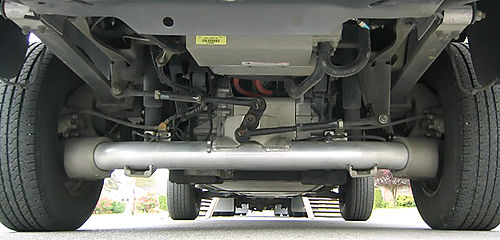Ford Ranger EV
Other than these minor differences, the Ranger EV included the standard features that the Ranger XL 4X2 Regular Cab included as standard: an AM and FM radio, two speakers, fifteen-inch alloy wheels, a bench seat or bucket seats trimmed in cloth, air conditioning and a heater, an automatic transmission, two airbags, seating for either two or three passengers, a passenger airbag on/off switch activated by the vehicle's ignition and door key, and vinyl flooring.
[citation needed] The principal identifiers of an electric Ranger are the appearance of the front charging door in a grille location that is open on ICE (Internal Combustion Engine) Rangers, the missing tailpipe, and the visibility of the EV's unique rear suspension and the traction motor from behind the vehicle.
The spare tire could be secured by a hold down within the truck bed, apparently on the centerline approximately 30 inches from the cab wall.
The unmodified cargo bed was compatible with after-market tonneau covers produced for gasoline engine models.
Ford attempted to make the driving and operating experience as similar as possible to that experienced in an ICE vehicle with an automatic transmission.
A column shifter style selector operates similar to that for an automatic transmission with the following positions: P for park, R for reverse, N for neutral, D for drive, and E for economy.
[4] A conventional switch arrangement is used to provide key inserted detection at Off, Accessory, Run, and Start.
The rear suspension consists of a De Dion tube that located the wheels and which was sprung by the usual longitudinal leaf springs.
The rear wheels are powered by a six pole alternating current motor operating through a (single speed) three to one reduction transmission and differential.
The motor, transmission, and differential are contained in a single unit mounted high between the frame rails, transversely between the rear wheels.
[citation needed] On a very long downhill run one could obtain a noticeably higher state of charge than at the top (3,000 ft (910 m) elevation difference), so the energy recovery was demonstrably effective.
Power consumption for light duty suburban use is around 500 watt-hours per mile, both by the EPA figures for early models and by some owners' experience.
The Ford Ranger EV controller electronics will allow strong acceleration even when in 'E' economy shifter mode.
The lead-acid battery pack consisted of 39 valve-regulated lead-acid modules assembled by East Penn Manufacturing for Delphi, with a weight of 870.1 kg (1,918 lb), a nominal system voltage of 312 V, and a nominal capacity (to half of the fully charged capacity) of 60 Ah.
[6] The NiMH version delivered a true 65-mile (105 km) range at a steady 65 mph (105 km/h) speed on flat highways (normal operation with some reserve; in comparison the lead-acid version which is said to have a range of up to 65 miles (105 km) with hard tires and careful driving.
With an adapter or after an upgrade, Ranger EVs can use the newer public charging infrastructure being deployed nationwide that utilizes the new J1772-2010 standard.
It was expected that Ford, like other companies, would completely destroy almost all remaining stocks by crushing, as has been done by several other major vehicle manufacturers.
This plan engendered considerable resistances from electric vehicle fans, with the adverse publicity prompting a change in Ford's policy.
While most of the 1,500 vehicles produced have since been destroyed, a number of Ranger EVs have been parted out for spares and the remaining several hundred units have been refurbished (using selected used and new old stock batteries) and other salvage components (both with lead-acid and NiMH batteries) by a third-party company (Blue Sky Motors of Sacramento, California).
The Azure Transit Connect Electric has an EPA range of 56 miles (90 km), almost identical to that of the Ford Ranger EV.
Several Ford Ranger EV's were "rescued" in 2008 and transported to Norway, where a company named Elbil Import sells them to end users.




